Production Improvement via Optimization of Hydraulic Acid Fracturing Design Parameters in a Tight Carbonate Reservoir
Abstract
:1. Introduction
2. Input Parameters
3. Mechanical Earth Modeling
- ✓
- Friction angle (FANG):
- ✓
- Brittleness Index (B):
- ✓
- Brittleness Factor (BRF):
- ✓
- Pore pressure offset:
- ✓
- Stress offset (∆S):
- ✓
- Process Zone Stress (PZS):
- ✓
- Critical Fissure Opening Pressure (CFOP):
- ✓
- Transmissibility Factor (T):
- ✓
- Total Fracability Index (TFI):
- ✓
- Containment Index (CI):
- ✓
- Thickness Index (TI):
4. Design and Optimization of Injection Parameters
5. Results and Discussion
5.1. Candidate Selection
5.2. Breakdown Pressure
5.3. Optimum Injection Parameters and Fracture Geometry
5.3.1. Optimum Injection Rate
5.3.2. Optimum Injection Fluid Volume
5.3.3. Optimum Number of Stages
5.4. Effect on Production Performance
6. Summary Conclusions and Future Work
- Using the MEM model results, the required breakdown pressure for Middle Eastern carbonate rocks at depth of 3600 m (11,811 ft) was about 17,000 psi, which would require three pump trucks.
- The optimized injection parameters were found: the optimal rate was 18 barrels per minute, the total injection volume was 90 K-gal (2143 bbl), and the optimal number of stages of injection was three. Using the optimized injection parameters, the optimized fracture geometrical sizes were determined: the fracture half-length (Lf): 148 m (486 ft), fracture height (Hf) of 64 m (210 ft) and fracture width (Wf) of 0.0962 in.
- The well production rate showed to increase from 840 STB/Day (before fracturing) to 1270 STB/Day (after fracturing), which shows 51% increase in production rate. For further confirmation, the application/extension of this specific study to other sites is planned as future studies.
- As a limitation of this work, a static prediction of the effect of acid fracturing on the tight carbonate was performed. In future work, a dynamic post-fracturing simulation should be performed to investigate possible time-based closing of the created fractures in reservoir-B. There is also an uncertainty in the fracture permeability. As another future study, the comparison of acid fracturing with proppant fracturing is important in this formation.
- Using past hydraulic acid fracturing data, the application of machine learning techniques and algorithms is also recommended to further optimize the operational parameters [40].
Author Contributions
Funding
Institutional Review Board Statement
Informed Consent Statement
Data Availability Statement
Acknowledgments
Conflicts of Interest
Nomenclature
| B | Brittleness index |
| BRF | Brittleness Factor |
| CFOP | Critical Fissure Opening Pressure |
| BHP | Bottomhole Pressure |
| CI | Containment Index |
| CMHPG | Carboxy Methyl Hydroxyl Propyl Guar |
| E | Young’s modulus [pa] or [psi] |
| FANG | Internal friction angle [deg] |
| FI | Fracability Index |
| Hf | Fracture height [m] or [ft] |
| Kf | Fracture permeability [D] |
| Lf | Fracture length [m] or [ft] |
| LOT | Leak-Off Test |
| MEM | Mechanical Earth Model |
| PZS | Process Zones Stress [pa] or [psi] |
| Q | Production rate [STB/Day] |
| Minimum horizontal (in-situ) stress | |
| Maximum horizontal (in-situ) stress | |
| STB/Day | Stock-tank barrel per day (rate of production) |
| Stress offset [pa] or [psi] | |
| TFI | Total Fracability Index |
| TI | Thickness Index |
| Vs | Shale volume |
| Wf | Fracture width [in] |
| Poisson’s ratio | |
| n (subscript) | Normalized |
Appendix A
| Fracability Index (FI) | Qualitative Rank | Geomechanical Unit |
|---|---|---|
| 0–0.2 | Very Weak | GMU-1 |
| 0.2–0.3 | Weak | GMU-2 |
| 0.3–0.37 | Weak | GMU-3 |
| 0.37–0.45 | Moderate | GMU-4 |
| 0.45–0.52 | Moderate | GMU-5 |
| 0.52–0.6 | Moderate | GMU-6 |
| 0.6–0.7 | Good | GMU-7 |
| 0.7–1 | Very Good | GMU-8 |
| Thickness Index (TI) | Qualitative Rank |
|---|---|
| 0–0.2 | Very Weak |
| 0.2–0.35 | Weak |
| 0.35–0.5 | Moderate |
| 0.5–0.7 | Good |
| 0.7–1 | Very Good |
| Layer Thickness [m] | Thickness Index (TI) | Qualitative Rank |
|---|---|---|
| 0–5 | 0–0.05 | Very Weak |
| 5–20 | 0.05–0.2 | Weak |
| 20–50 | 0.2–0.5 | Moderate |
| 50–100 | 0.5–1 | Good |
| >100 | >1 | Very Good |
References
- Economides, M.J.; Nolte, K.G. Reservoir Stimulation, 3rd ed.; John Wiley and Sons: Hoboken, NJ, USA, 2000. [Google Scholar]
- Schwalbert, M.P.; Aljawad, M.S.; Hill, A.D.; Zhu, D. Decision Criterion for Acid Stimulation Method in Carbonate Reservoirs: Matrix Acidizing or Acid Fracturing? In Proceedings of the SPE International Conference and Exhibition on Formation Damage Control, Lafayette, LA, USA, 19–21 February 2020. [Google Scholar] [CrossRef]
- Daneshy, A.; Valkó, P.; Norman, L. Well Stimulation. In Petroleum Well Construction; Economides, M.J., Watters, L.T., Dunn-Norman, S., Eds.; Wiley: New York, NY, USA, 1998; Chapter 17. [Google Scholar]
- Neumann, L.F.; Oliveira, T.J.; Fernandes, P.D.; de Oliveira e Sousa, J.L.; Brandão, E.M. Building Acid Frac Conductivity in Highly-Confined Carbonates. In Proceedings of the Society of Petroleum Engineers—SPE Hydraulic Fracturing Technology Conference, The Woodlands, TX, USA, 6–8 February 2012. [Google Scholar] [CrossRef]
- Azevedo, C.T.; Rosolen, M.A.; Rocha, J.D.H.; Neumann, L.F.; Melo, R.C.L. Challenges Facedto Execute Hydraulic Fracturing in Brazilian Pre-Salt Wells; American Rock Mechanics Association: Alexandria, VA, USA, 2010. [Google Scholar]
- Oliveira, T.J.L.; Neumann, L.F.; Azevedo, C.T. Acid or Propped Fracturing in Deep Carbonates? Experiments and Field Results. In Proceedings of the Society of Petroleum Engineers—SPE International Symposium and Exhibition on Formation Damage Control, Lafayette, LA, USA, 19–21 February 2014. [Google Scholar] [CrossRef]
- Ali, S.A.; Kalfayan, L.; Montgomery, C. Acid Stimulation; SPE Monograph Series; Society of Petroleum Engineers: Richardson, TX, USA, 2016; Volume 26, ISBN 978-1-61399-426-9. [Google Scholar]
- Suleimenova, A.; Wang, X.; Zhu, D.; Hill, A.D. Comparative Study of Acid Fracturing and Propped Hydraulic Fracturing for a Tight Carbonate Formation. In Proceedings of the SPE EUROPEC Featured at 78th EAGE Conference and Exhibition, Vienna, Austria, 30 May–2 June 2016. [Google Scholar] [CrossRef]
- Oeth, C.V.; Hill, A.D.; Zhu, D. Acid Fracture Treatment Design with Three-Dimensional Simulation. In Proceedings of the SPE Hydraulic Fracturing Technology Conference, The Woodlands, TX, USA, 4–6 February 2014. [Google Scholar] [CrossRef]
- Deng, J.; Mou, J.; Hill, A.D.; Zhu, D. A New Correlation of Acid Fracture Conductivity Subject to Closure Stress. In Proceedings of the SPE Hydraulic Fracturing Technology Conference, The Woodlands, TX, USA, 24–26 January 2011. [Google Scholar] [CrossRef]
- Chong, K.K.; Grieser, B.; Jaripatke, O.; Passman, A. A Completion Roadmap to Shale-Play Development. In Proceedings of the CPS/SPE International Oil & Gas Conference and Exhibition, Beijing, China, 8–10 June 2010. SPE 130369. [Google Scholar] [CrossRef]
- King, G.E. Thirty Years of Gas Shale Fracturing. In Proceedings of the SPE Annual Technical Conference and Exhibition, Florence, Italy, 19–22 September 2010. SPE 133456. [Google Scholar] [CrossRef]
- King, G.E. 60 Years of Multi-Fractured Vertical, Deviated and Horizontal Wells: What Have We Learned? In Proceedings of the SPE Annual Technical Conference and Exhibition, Amsterdam, The Netherlands, 27–29 October 2014. SPE 17095. [Google Scholar] [CrossRef]
- Allix, P.; Burnham, A.; Fowler, T.; Herron, M.; Kleinberg, R.; Symington, B. Coaxing oil from shale. Oilfield Rev. 2011, 22, 4–16. [Google Scholar]
- Baihly, J.D.; Malpani, R.; Edwards, C.; Han, S.Y.; Kok, J.C.; Tollefsen, E.M.; Wheeler, C.W. Unlocking the Shale mystery: How Lateral Measurements and Well Placement Impact Completions and Resultant Production. In Proceedings of the SPE Annual Technical Conference and Exhibition, Florence, Italy, 19–22 September 2010. SPE 138427. [Google Scholar] [CrossRef]
- Manchanda, R.; Sharma, M.M. Impact of Completion Design on Fracture Complexity in Horizontal Shale Wells. SPE Drill. Complet. 2014, 29, 78–87. [Google Scholar] [CrossRef]
- Kalfayan, L. Production Enhancement with Acid Stimulation, 2nd ed.; PennWell Corporation: Nashville, TN, USA, 2008; ISBN 978-1593703844. [Google Scholar]
- Rahim, Z.; Ahmed, M.S. Analysis of Long-Term Production Performance in Acid-Fractured Carbonate Wells. In Proceedings of the SPE Annual Technical Conference and Exhibition, Dallas, TX, USA; 2005. [Google Scholar] [CrossRef]
- Heydarabadi, F.R.; Moghadasi, J.; Safian, G.; Ashena, R. Criteria for Selecting a Candidate Well for Hydraulic Fracturing. In Proceedings of the Nigeria Annual International Conference and Exhibition, Tinapa-Calabar, Nigeria, 31 July–7 August 2010. SPE 136988. [Google Scholar] [CrossRef]
- Bale, A.; Smith, M.B.; Henry, H.K. Stimulation of Carbonates Combining Acid Fracturing with Proppant (CAPF): A Revolutionary Approach for Enhancement of Sustained Fracture Conductivity and Effective Fracture Half-Length. In Proceedings of the SPE Annual Technical Conference and Exhibition, Florence, Italy, 19–22 September 2010. [Google Scholar] [CrossRef]
- Blanton, T.L. Propagation of Hydraulically and Dynamically Induced Fractures in Naturally Fractured Reservoirs. In Proceedings of the SPE Unconventional Gas Technology Symposium, Louisville, KY, USA, 18–21 May 1986. SPE 15261-MS. [Google Scholar] [CrossRef]
- Guo, J.C.; Luo, B.; Zhao, X.; Zhu, H.A. Numerical simulation of interaction of hydraulic fracture and natural fracture based on the cohesive zone finite element method. J. Nat. Gas Sci. Eng. 2015, 25, 180–188. [Google Scholar] [CrossRef]
- Shadizadeh, S.R.; Habibnia, B.; Syllabee, R. Investigation and selection of suitable layers in Bangestan reservoir for hydraulic fracturing operation. Sceitia Iran. Trans. C Chem. Chem. Eng. 2009, 16, 149–160. [Google Scholar]
- Heydarabadi, F.R.; Moghadasi, J.; Safian, G.A. Hydraulic Fracturing in Iran-Lessons from Four Case Histories. In Proceedings of the SPE Production and Operations Conference and Exhibition, Tunis, Tunisia, 8–10 June 2010. [Google Scholar] [CrossRef]
- Aminzadeh, F. Hydraulic Fracturing. In Fossil Energy. Encyclopedia of Sustainability Science and Technology Series; Malhotra, R., Ed.; Springer: New York, NY, USA, 2020. [Google Scholar] [CrossRef]
- Plumb, R. Influence of composition and texture on the failure properties of clastic rocks. In Proceedings of the SPE 28022-MS, Rock Mechanics in Petroleum Engineering, Delft, The Netherlands, 29–31 August 1994. [Google Scholar]
- Ashena, R.; Elmgerbi, A.; Rasouli, V.; Ghalambor, A.; Rabiei, M.; Bahrami, A. Severe wellbore instability in a complex lithology formation necessitating casing while drilling and continuous circulation system. J. Pet. Explor. Prod. Technol. 2020, 10, 1511–1532. [Google Scholar] [CrossRef] [Green Version]
- Rickman, R.; Mullen, M.; Petre EGrieset, B.; Kundert, D. A Practical Use of Shale Prtrophysics for Stimulation Design Optimization: All Shale Plays Are Not Clones of the Barnett Shale. In Proceedings of the SPE ATCE, Denver, CO, USA, 21–24 September 2008. SPE 115258. [Google Scholar] [CrossRef] [Green Version]
- Jin, X.; Shah, S.N.; Roegiers, J.C. Fracability evaluation in shale reservoirs—An integrated petrophysics and geomechanics approach. SPE J. 2014, 20, 518–526. [Google Scholar] [CrossRef]
- Sun, J.M.; Han, Z.L.; Qin, R.B.; Zhang, J. Log evaluation method of fracturing performance in tight gas reservoir. Acta Pet. Sin. 2015, 36, 74–80, (In Chinese with English Abstract). [Google Scholar] [CrossRef]
- Li, J.; Li, X.-R.; Zhan, H.-B.; Song, M.-S.; Liu, C.; Kong, X.-C.; Sun, L.-N. Modified method for fracability evaluation of tight sandstones based on interval transit time. Pet. Sci. 2020, 17, 477–486. [Google Scholar] [CrossRef] [Green Version]
- Mullen, M.J.; Enderlin, M.B. Fracability Index—More Than Rock Properties. In Proceedings of the SPE Annual Technical Conference and Exhibition, San Antonio, TX, USA, 8–10 October 2012. SPE 159755. [Google Scholar] [CrossRef]
- Zhang, F.; Zhang, H.; Yuan, F.; Wang, Z.; Chen, S.; Li, C.; Han, X. Geomechanical Mechanism of Hydraulic Fracturing and Fracability Evaluation of Natural Fractured Tight Sandstone Reservoir in Keshen Gasfield in Tarim Basin. In Proceedings of the Abu Dhabi International Petroleum Exhibition and Conference, Abu Dhabi, United Arab Emirates, 9–12 November 2015. SPE 177457. [Google Scholar] [CrossRef]
- Dagdeviren, M. Decision making in equipment selection: An integrated approach with AHP and PROMETHEE. J. Intell. Manuf. 2008, 19, 376–406. [Google Scholar] [CrossRef]
- Simonson, E.R.; Abou-Sayed, A.S.; Clifton, R.J. Containment of Massive Hydraulic Fractures. SPE J. 1978, 18, 27–32. [Google Scholar] [CrossRef]
- Mata, D.; Zhou, Y.; Ma, Y.Z.; Gonzales, V. Hydraulic Fracture Treatment, Optimization, and Production Modeling. In Unconventional Oil and Gas Resources Handbook; Ma, Y.Z., Holditch, S.A., Eds.; Gulf Professional Publishing: Woburn, MA, USA, 2016; Chapter 8; pp. 215–242. ISBN 9780128022382. [Google Scholar] [CrossRef]
- Leguizamon, J.; Aguilera, R. Hydraulic Fracturing of Naturally Fractured Tight Gas Formations. In Proceedings of the SPE Middle East Unconventional Gas Conference and Exhibition, Muscat, Oman, 31 January–2 February 2011. SPE 142727-MS. [Google Scholar] [CrossRef]
- Langbauer, C.; Herbert, H.; Albina, M. Bio Enhanced Energy Recovery Technology for Clean and Efficient Energy Production. In Proceedings of the SPE Asia Pacific Oil and Gas Conference and Exhibition, Brisbane, Australia, 23–25 October 2018. SPE 192122. [Google Scholar] [CrossRef]
- Corbett, P. Is Our Carbonate Reservoir Fractured or not? Adapted from 2013–2014 AAPG Foundation Distinguished Lecture. 2014. Available online: http://www.searchanddiscovery.com/pdfz/documents/2014/41485corbett/ndx_corbett.pdf.html (accessed on 12 August 2020).
- Rezaei, R.; Aminzadeh, F.; Von Lunen, E. Applications of Machine Learning for Estimating the Stimulated Reservoir Volume (SRV) URTeC: 5537. In Proceedings of the Unconventional Resources Technology Conference, Houston, TX, USA, 26–28 July 2021. [Google Scholar]
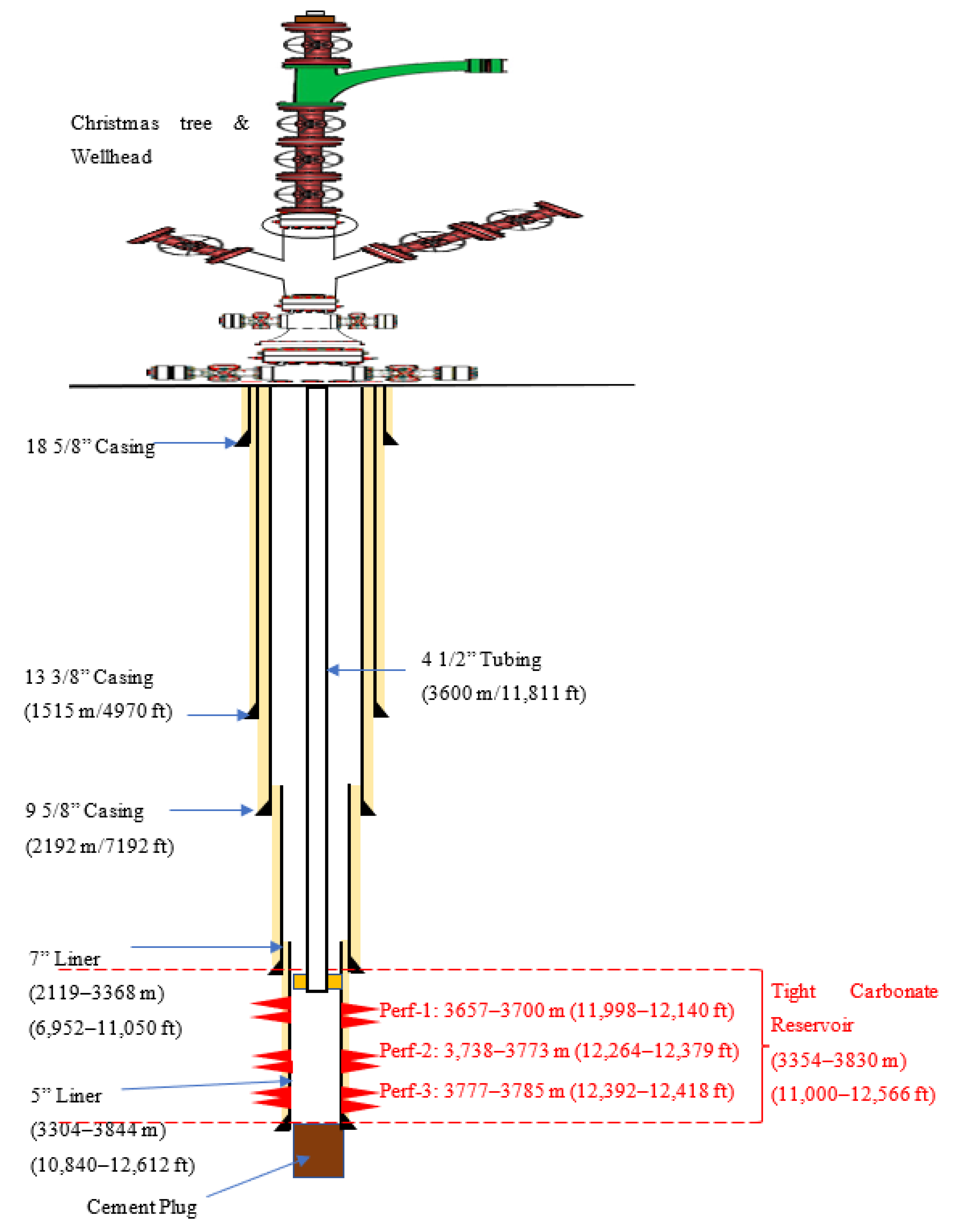
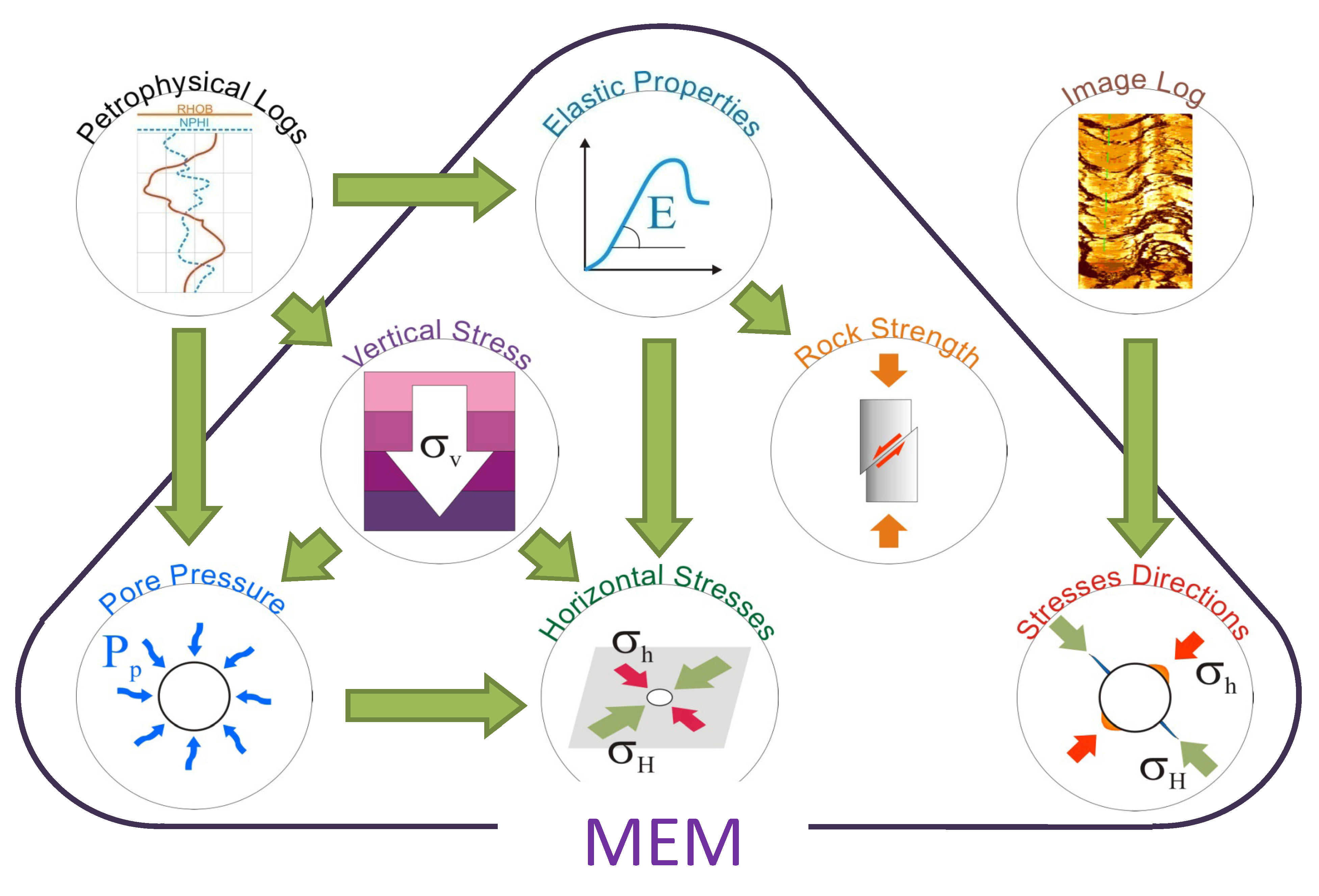
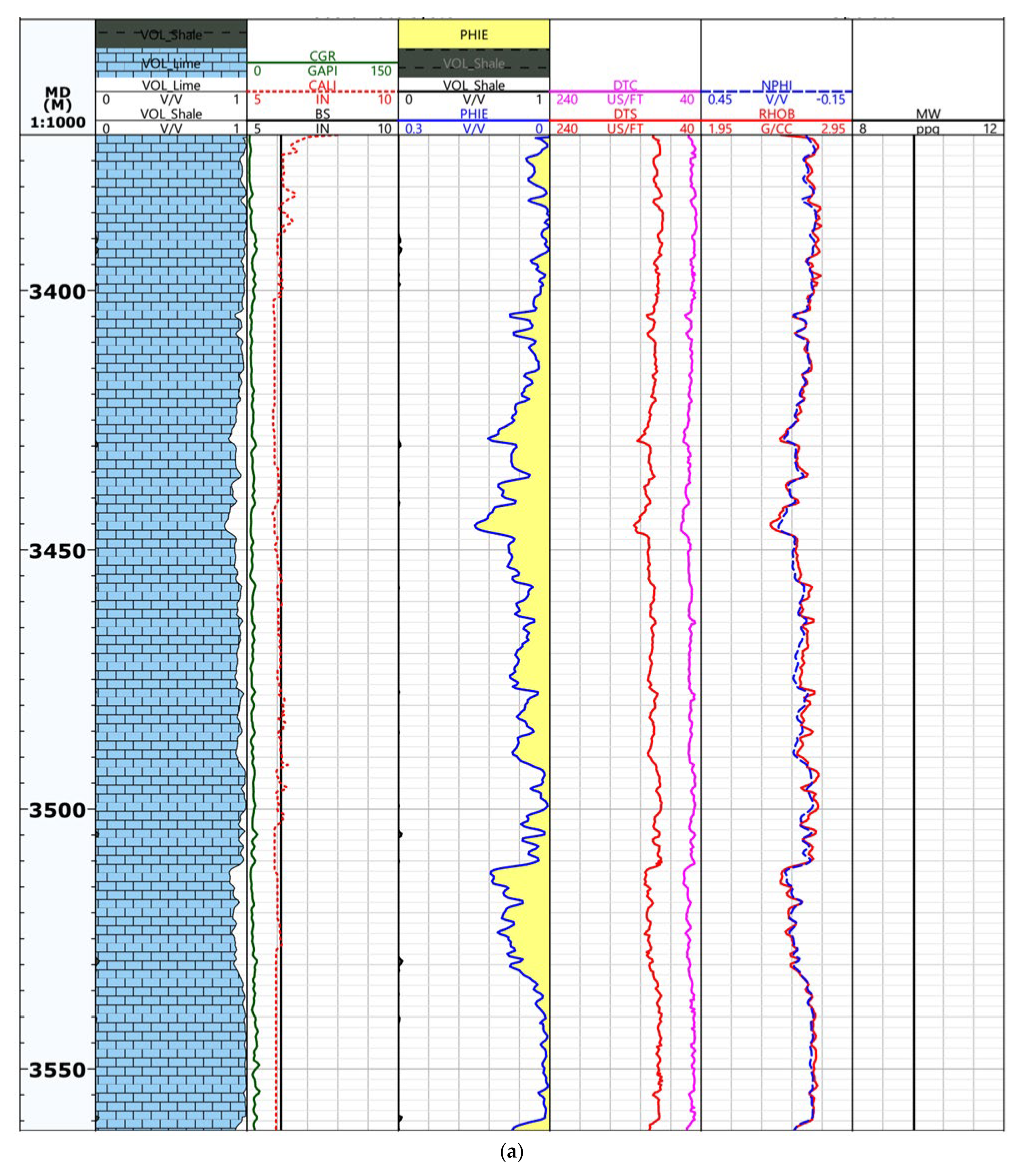
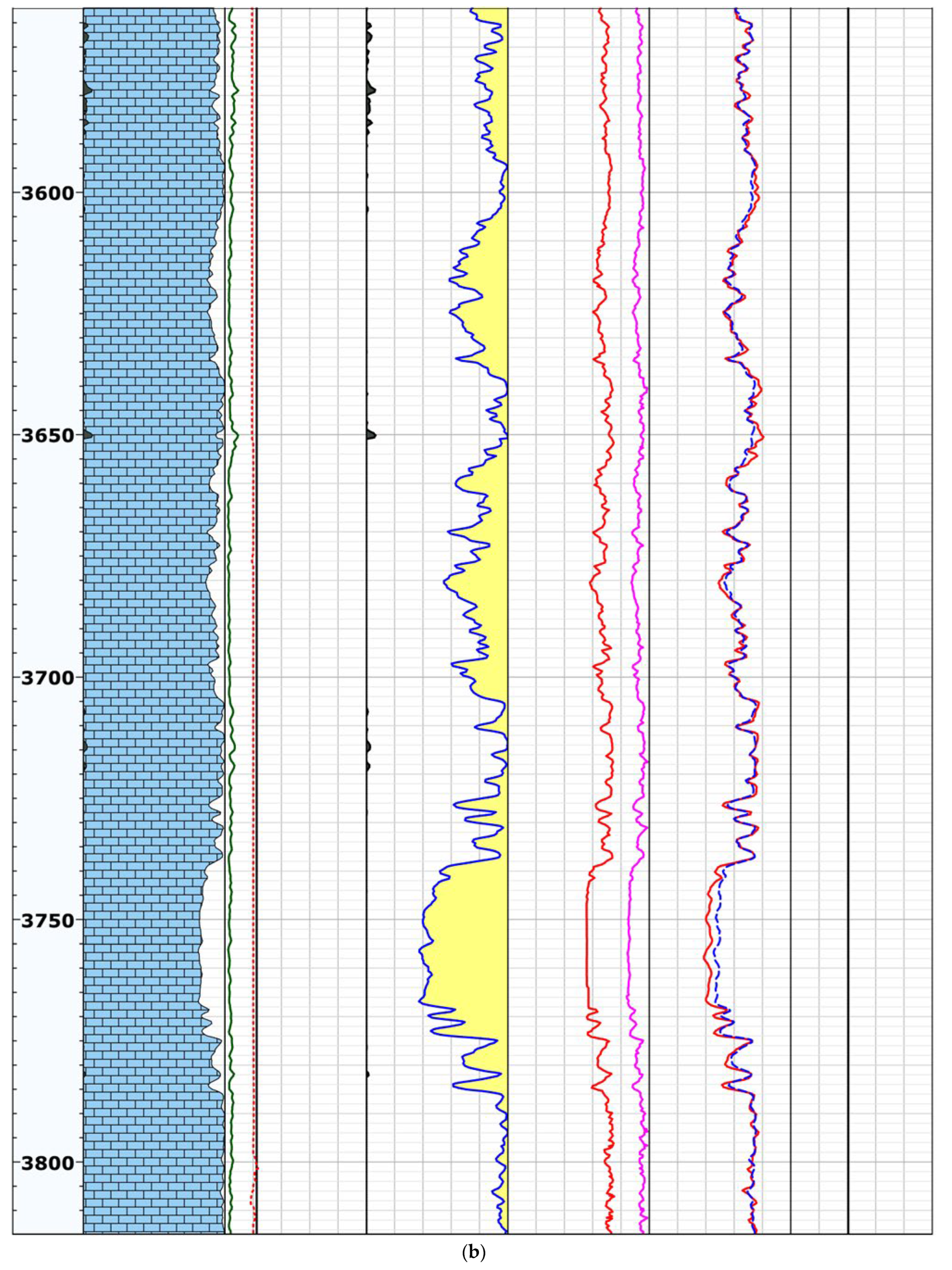
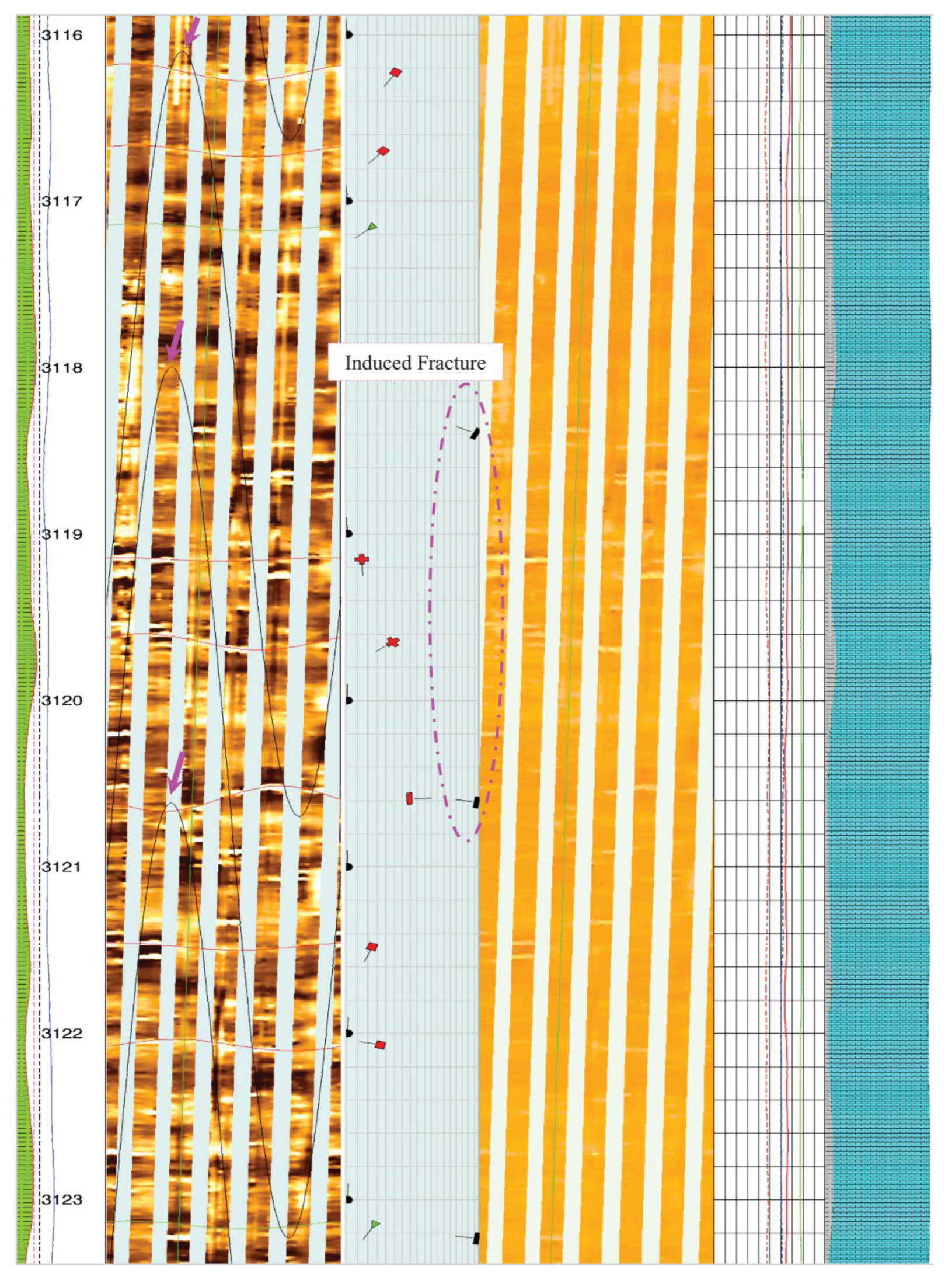
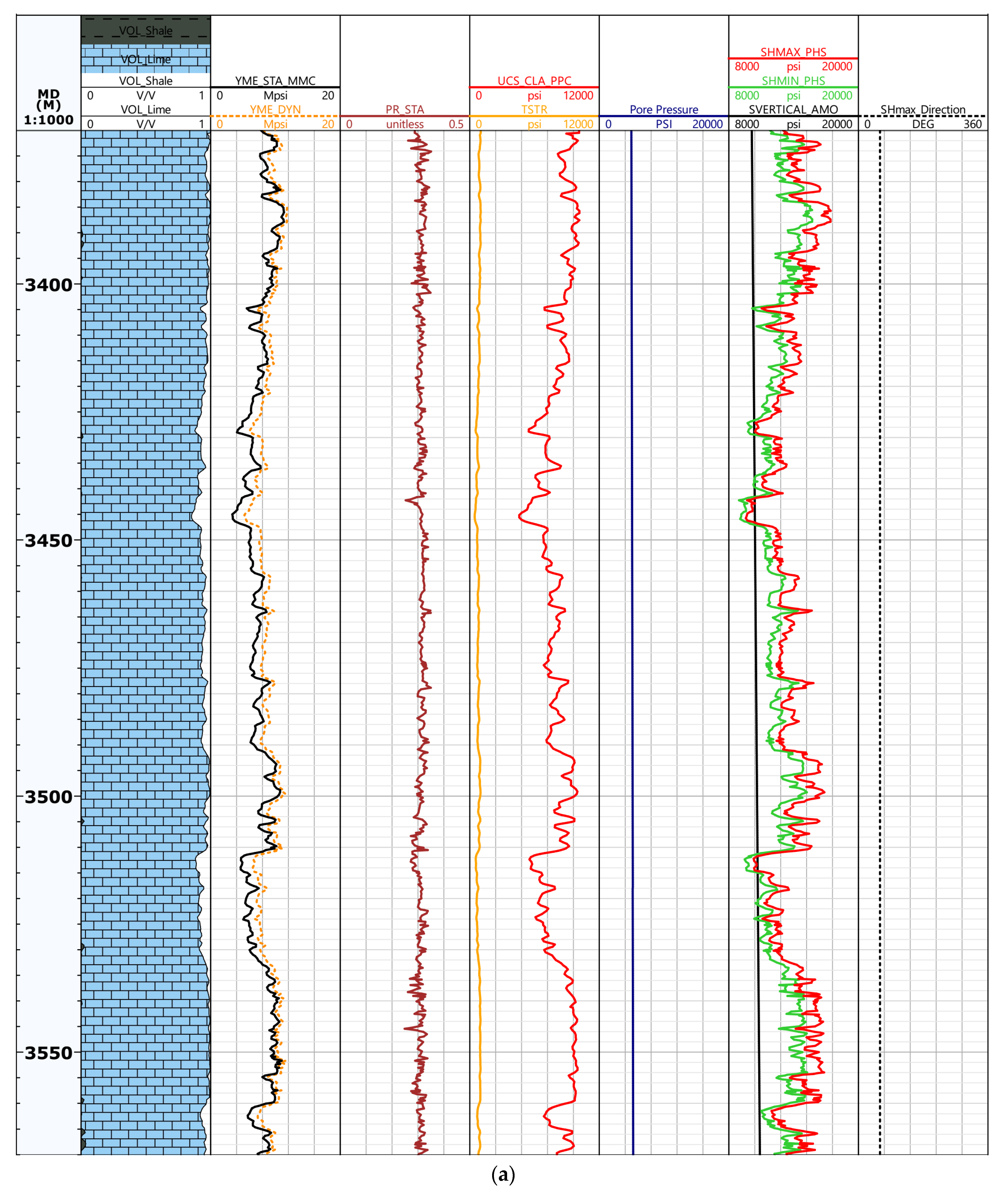
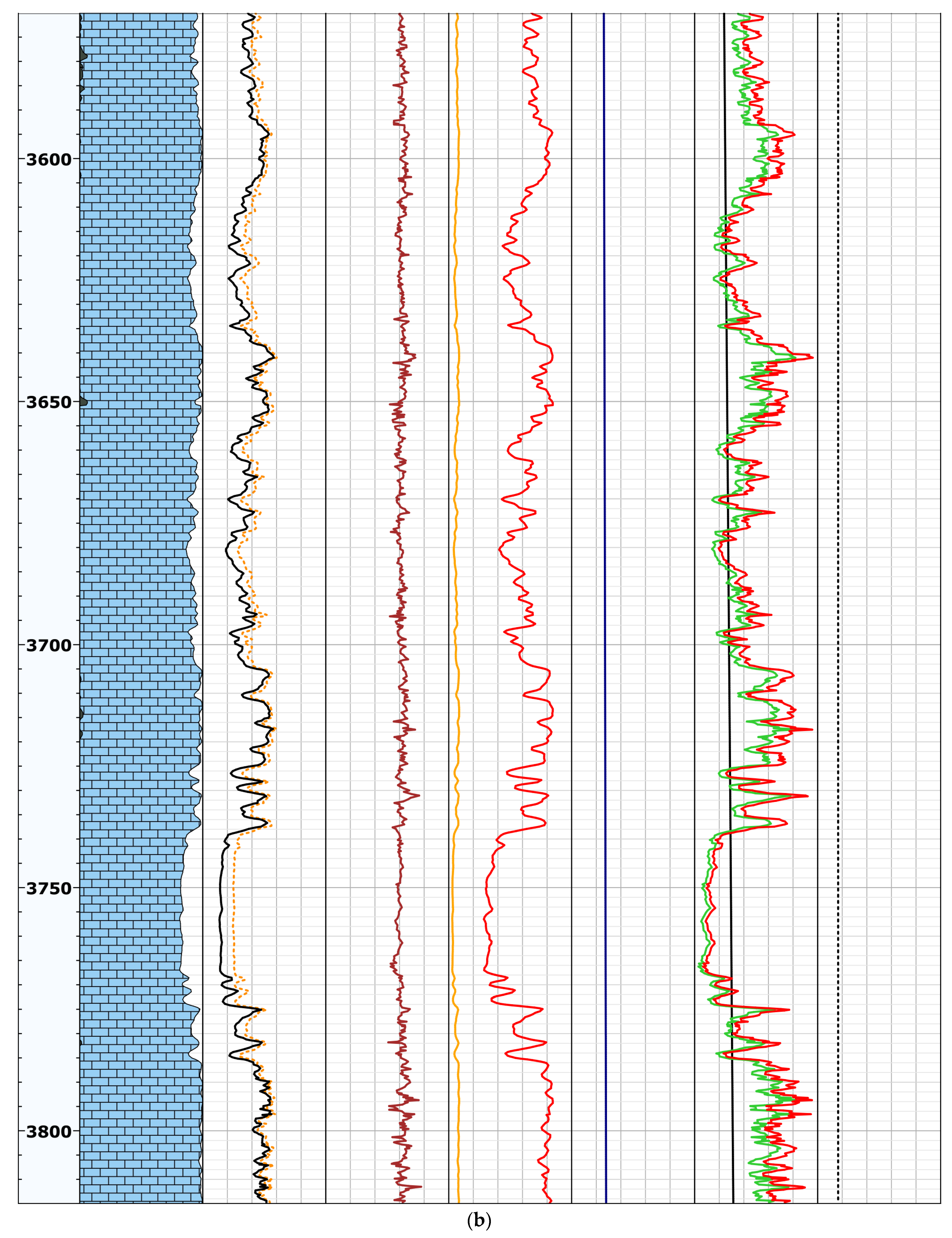

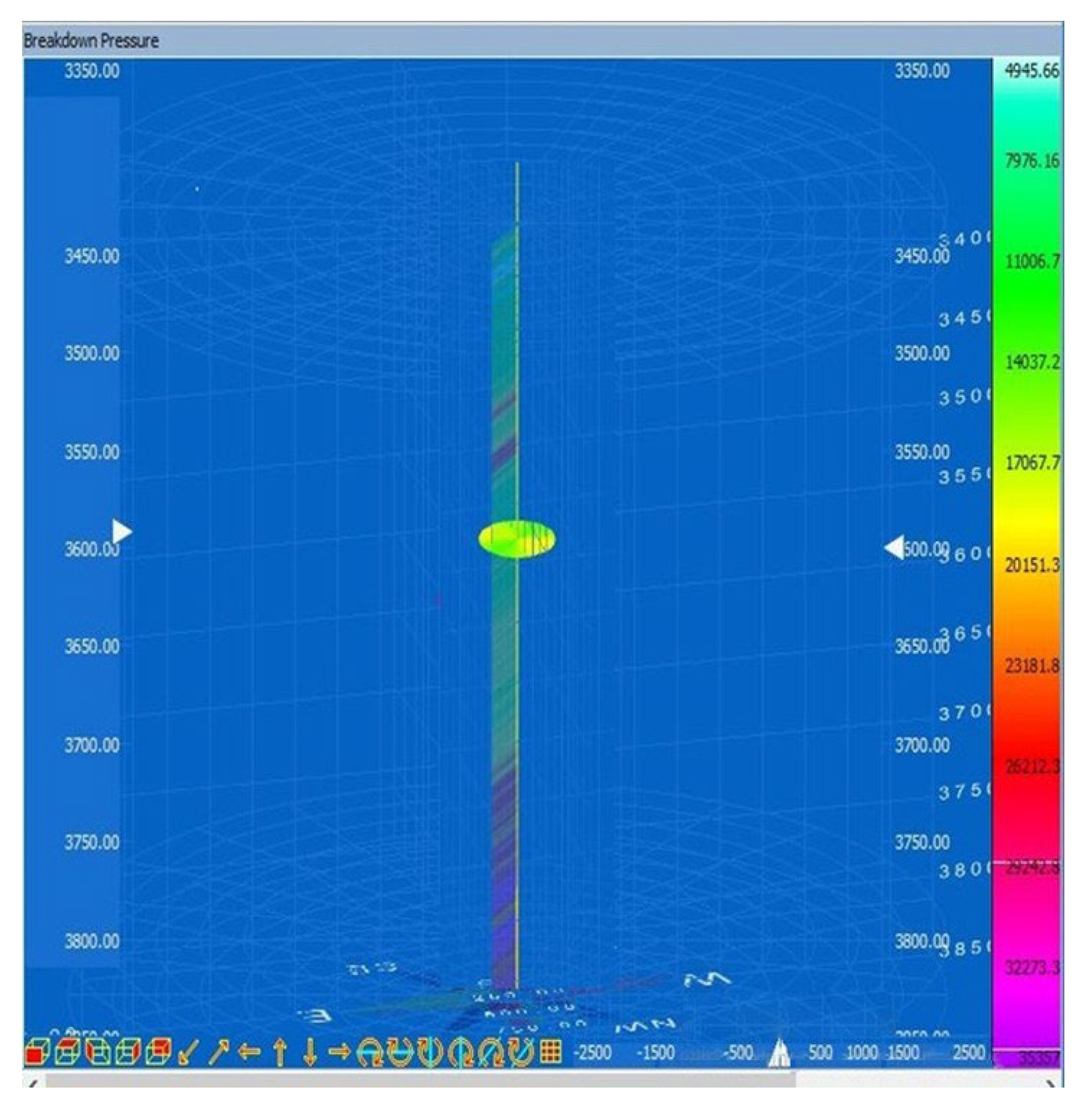

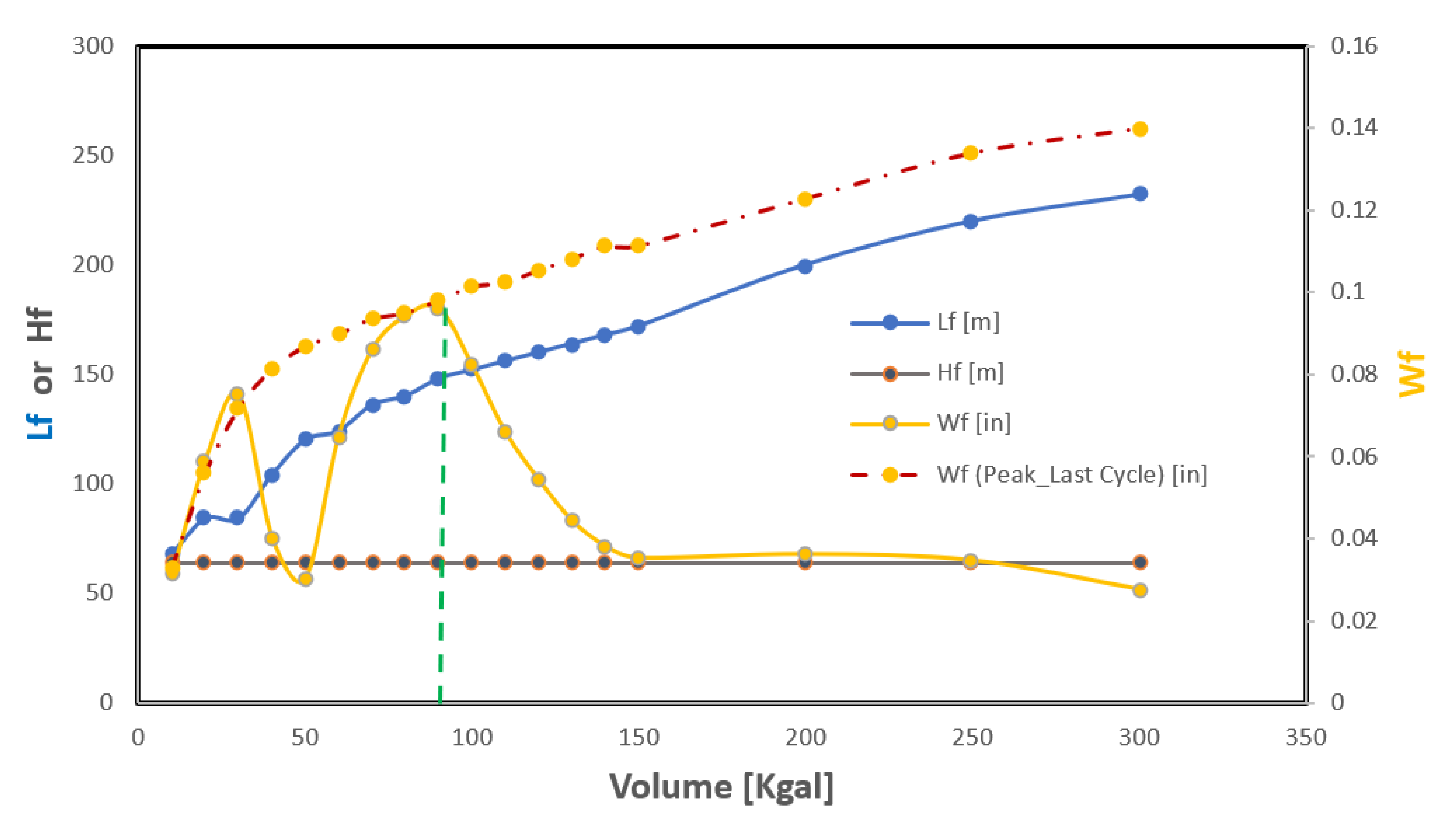


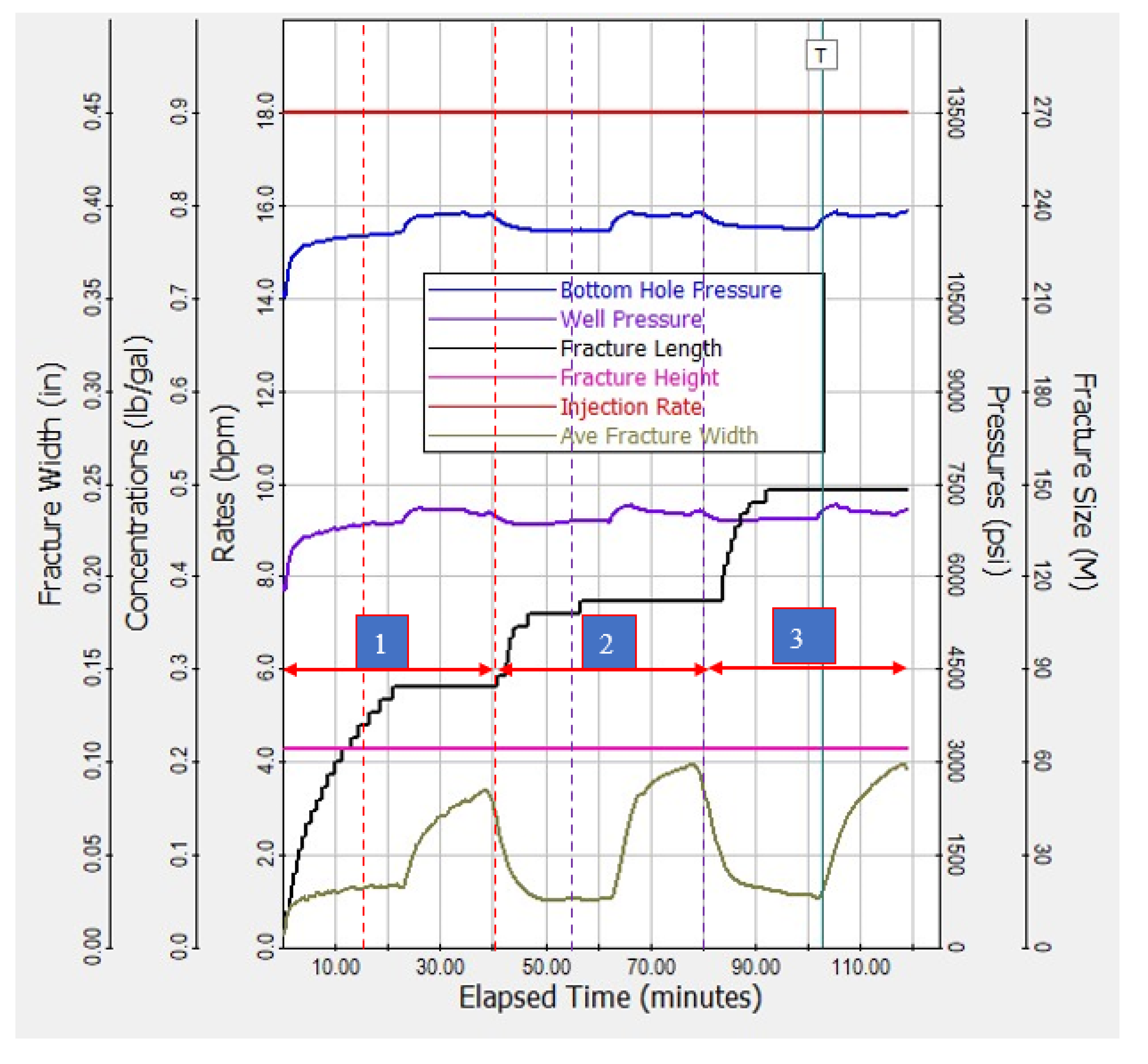
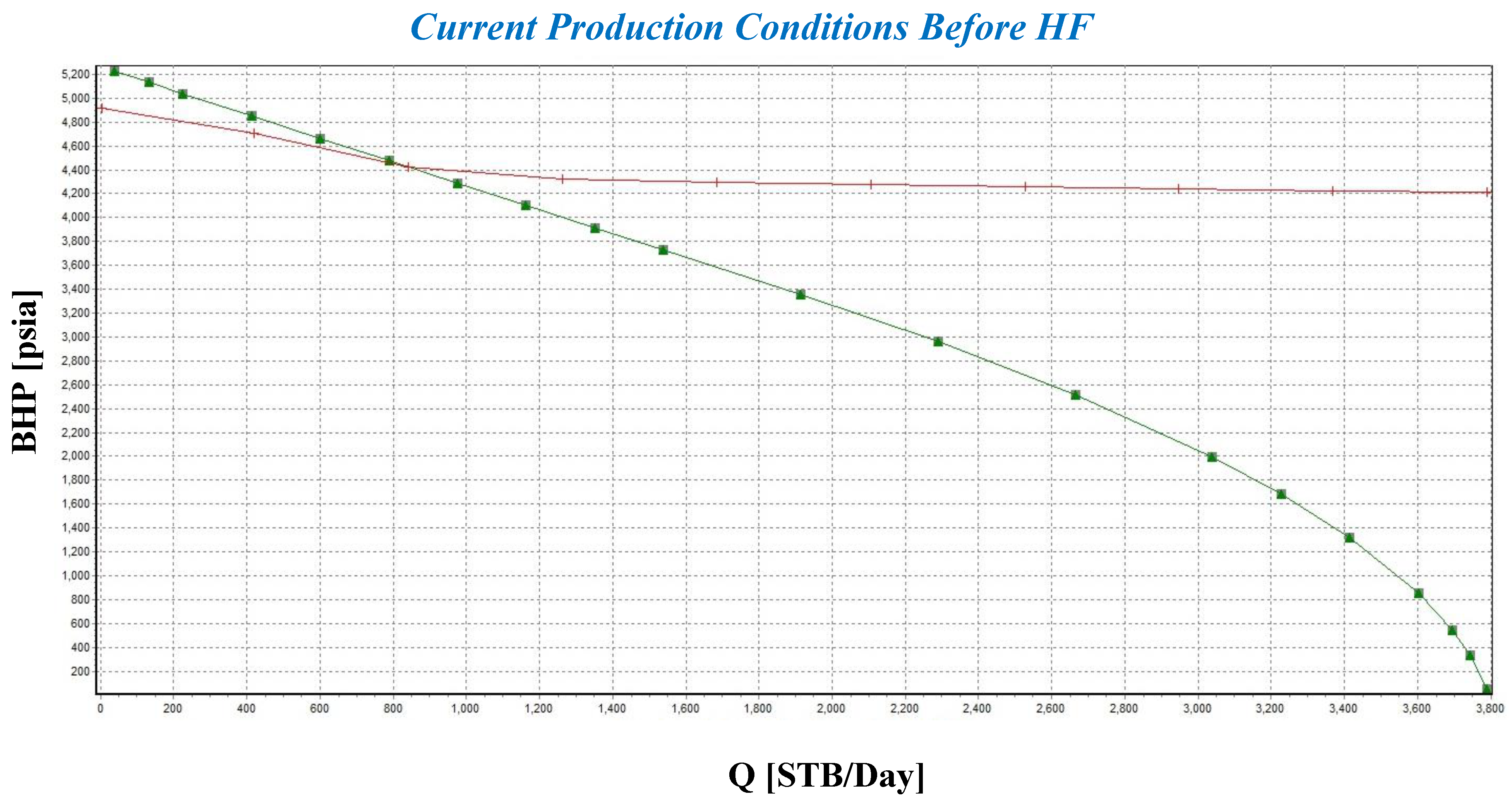

| Parameter | Value | |
|---|---|---|
| Rock Properties | Porosity | 6.5% (on average) (depth-based well log is given) |
| Permeability | 4 mD | |
| Rock Compressibility | 10−5 1/psi | |
| Reservoir Thickness (perforation Interval in Cased Hole): | 128 m (3657–3785 m) (420 ft) | |
| Acid Coefficients | Limestone Reaction Order | 0.7 |
| Dolomite Reaction Order | 0.3 | |
| Limestone Reaction Rate | 1600 mole/s | |
| Dolomite Reaction Rate | 0.005 mole/s | |
| Fluid Properties | Viscosity at 116 °C (240 °F) | 1.66 |
| Oil API Gravity | 24.3 | |
| Oil Formation Volume Factor, Bo | 1.141 bbl/STB | |
| Pore Pressure | (measured versus depth) | |
| Bubble Point Pressure | 1439 psi | |
| Oil Pressure Gradient | 0.35 psi.ft | |
| Gas Oil Ratio | 430 scf/STB | |
| Oil Compressibility | 1/psi | |
| Water Compressibility | 1/psi | |
| CO2 | 1.2% | |
| N2 | 0.28% | |
| H2S | 0.47% | |
| HCl Acid Concentration | 15% | |
| Polymer Type | CMHPG#35_Zr_180 (Carboxy Methyl Hydroxyl Propyl Guar) | |
| Reservoir Pressure & Temperature | Pressure | 5255 psi |
| Temperature | 116 °C (240 °F) | |
| Temperature Gradient | 0.018 °C/m (0.01 °F/ft) | |
| Production Parameters | Gas Oil Ratio (GOR) | 385 scf/STB |
| Water Cut | 0.4% | |
| Productivity Index (before Hydraulic Fracturing) | 3.175 STB/Day/psi |
| Total Fracability Index (TFI) | Containment Index (CI) | Thickness Index (TI) | Quality | |
|---|---|---|---|---|
| Perf-1 (3657–3700 m) (11,998–12,140 ft) | 0.41–0.56 (GMU-4 to 6) | 0.15–0.42 (Weak to Moderate) | 0.04–0.2 (Weak) | Mostly Moderate |
| Perf-2 (3738–3773 m) (12,264–12,379 ft) | 0.41–0.51 (GMU-4 to 5) | 0.002–0.27 (Very Weak to Weak) | 0.03–0.17 (Weak) | Very Weak to Weak |
| Perf-3 (3777–3785 m) (12,392–12,418 ft) | 0.41–0.6 (GMU-4 to 6) | 0.12–0.46 (Very Weak to Moderate) | 0.17–0.17 (Weak to Moderate) | Mostly Moderate |
| Parameter | Value | |
|---|---|---|
| Lf: | 148 m | (485.58 ft) |
| Hf: | 64 m | (209.98 ft) |
| Wf: | 0.0962 in | (0.008 ft) |
| Kf [D] | Q [STB/D] | BHP [psi] | |
|---|---|---|---|
| Value | Characteristic | ||
| 10 | Poor | 850 | 4483 |
| 20 | Medium | 972 | 4440 |
| 50 | Good | 1270 | 4350 |
| 100 | Excellent | 1525 | 4304 |
Publisher’s Note: MDPI stays neutral with regard to jurisdictional claims in published maps and institutional affiliations. |
© 2022 by the authors. Licensee MDPI, Basel, Switzerland. This article is an open access article distributed under the terms and conditions of the Creative Commons Attribution (CC BY) license (https://creativecommons.org/licenses/by/4.0/).
Share and Cite
Ashena, R.; Aminzadeh, F.; Khoramchehr, A. Production Improvement via Optimization of Hydraulic Acid Fracturing Design Parameters in a Tight Carbonate Reservoir. Energies 2022, 15, 1947. https://doi.org/10.3390/en15051947
Ashena R, Aminzadeh F, Khoramchehr A. Production Improvement via Optimization of Hydraulic Acid Fracturing Design Parameters in a Tight Carbonate Reservoir. Energies. 2022; 15(5):1947. https://doi.org/10.3390/en15051947
Chicago/Turabian StyleAshena, Rahman, Fred Aminzadeh, and Amir Khoramchehr. 2022. "Production Improvement via Optimization of Hydraulic Acid Fracturing Design Parameters in a Tight Carbonate Reservoir" Energies 15, no. 5: 1947. https://doi.org/10.3390/en15051947





